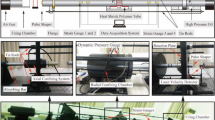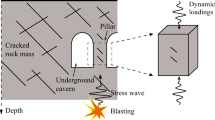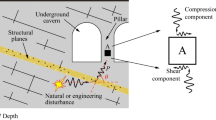Abstract
A novel method is developed for characterizing the mechanical response and failure mechanism of brittle rocks under dynamic compression-shear loading: an inclined cylinder specimen using a modified split Hopkinson pressure bar (SHPB) system. With the specimen axis inclining to the loading direction of SHPB, a shear component can be introduced into the specimen. Both static and dynamic experiments are conducted on sandstone specimens. Given carefully pulse shaping, the dynamic equilibrium of the inclined specimens can be satisfied, and thus the quasi-static data reduction is employed. The normal and shear stress–strain relationships of specimens are subsequently established. The progressive failure process of the specimen illustrated via high-speed photographs manifests a mixed failure mode accommodating both the shear-dominated failure and the localized tensile damage. The elastic and shear moduli exhibit certain loading-path dependence under quasi-static loading but loading-path insensitivity under high loading rates. Loading rate dependence is evidently demonstrated through the failure characteristics involving fragmentation, compression and shear strength and failure surfaces based on Drucker–Prager criterion. Our proposed method is convenient and reliable to study the dynamic response and failure mechanism of rocks under combined compression-shear loading.
















Similar content being viewed by others
References
Abou-Sayed AS, Clifton RJ, Hermann L (1976) The oblique-plate impact experiment. Exp Mech 16(4):110–1120
Asef MR, Farrokhrouz M (2017) A semi-empirical relation between static and dynamic elastic modulus. J Pet Sci Eng. https://doi.org/10.1016/j.petrol.2017.06.055
Baker WW, Yew CH (1966) strain rate effects in the propagation of torsional plastic waves. J Appl Mech 33(6):917–923
Cai M, Kaiser PK, Suorineni F, Su K (2007) A study on the dynamic behavior of the Meuse/Hhaute-Marne argilite. Phys Chem Earth Parts A/B/C 32(8–14):907–916
Chen W, Zhang B, Forrestal MJ (1999) A split Hopkinson bar technique for low-impedance materials. Exp Mech 39:81–85
Chhabildas LC, Kipp ME (1985) Pressure-shear loading of PBX-9404. In: 8th symposium on detonation, Albuquerque, NM, p 274
Christensen RJ, Swanson SR, Brown WS (1972) Split-Hopkinson-bar tests on rock under confining pressure. Exp Mech 12(11):508–513
Colmenares LB, Zoback MD (2002) A statistical evaluation of intact rock failure criteria constrained by polyaxial test data for five different rocks. Int J Rock Mech Min Sci 39:695–729
Dai F, Huang S, Xia K, Tan Z (2010) Some fundamental issues in dynamic compression and tension tests of rocks using split Hopkinson pressure bar. Rock Mech Rock Eng 43(6):657–666
Dai F, Xu Y, Zhao T, Xu N, Liu Y (2016) Loading-rate-dependent progressive fracturing of cracked chevron notched Brazilian disc specimens in split Hopkinson pressure bar tests. Int J Rock Mech Min Sci 88:49–60
Doan M-L, Gary G (2009) Rock pulverization at high strain rate near the San Andreas fault. Nat Geosci 2(10):709–712
Drucker DC, Prager W (1952) Soil mechanics and plastic analysis for limit design. Q Appl Math 10(2):157–165
Fang D, Li Y, Zhao H (2010) On the behavior characterization of metallic cellular materials under impact loading. Acta Mech Sin 26:837–846
Frew DJ, Forrestal MJ, Chen W (2002) Pulse shaping techniques for testing brittle materials with a split Hopkinson pressure bar. Exp Mech 42(1):93–106
Fukui K, Okubo S, Ogawa A (2004) Some aspects of loading-rate dependency of Sanjome andesite strengths. Int J Rock Mech Min 41(7):1215–1219
Grady DE, Kipp ME (1987) Dynamic rock fragmentation. In: Atkinson BK (ed) Fracture mechanics of rock. Academic, London, pp 429–475
Green SJ, Perkins RD (1968) Uniaxial compression tests at varying strain rates on three geologic materials. In: The 10th U.S. symposium on rock mechanics (USRMS), Austin, TX
Gupta YM (1983) Shear and compression wave measurement in shocked polycrystalline Al2O3. J Geophys Res 88:4304–4312
Holmquist TJ, Johnson GR (2005) Characterization and evaluation of silicon carbide for high-velocity impact. J Appl Phys 97:093502
Hong ST, Pan J, Tyan T, Prasad P (2008) Dynamic crush behaviors of aluminum honeycombs specimens under compression dominant inclined loads. Int J Plast 24:89–117
Hopkinson B (1914) A method of measuring the pressure produced in the detonation of high explosives or by the impact of bullets. Philos Trans R Soc Lond Ser A Math Phys Eng Sci 213:437–456
Huang H, Feng R (2004) A study of the dynamic tribological response of closed fracture surface pairs by Kolsky bar compression shear experiment. Int J Solids Struct 41(11–12):2821–2835
Huang S, Feng XT, Xia K (2011) A dynamic punch method to quantify the dynamic shear strength of brittle solids. Rev Sci Instrum 82(5):053901–053905
Kolsky H (1953) Stress waves in solids. Clarendon Press, Oxford
Li XB, Lok TS, Zhao J, Zhao PJ (2000) Oscillation elimination in the Hopkinson bar apparatus and resultant complete dynamic stress-strain curves for rocks. Int J Rock Mech Min Sci 37(7):1055–1060
Lindholm US, Yeakley LM, Nagy A (1974) Dynamic strength and fracture properties of dresser basalt. Int J Rock Mech Min Sci 11(5):181–191
Magnenet V, Giraud A, Homand F (2008) Parameter sensitivity analysis for a Drücker–Prager model following from numerical simulations of indentation tests. Comput Mater Sci 44(2008):385–391
McCall KR, Guyer RA (1994) Equation of state and wave propagation in hysteretic nonlinear elastic materials. J Geophys Res 99(B12):23887–23897
Meyer LW, Staskewitsch E, Burblies A (1994) Adiabatic shear failure under biaxial dynamic compression/shear loading. Mech Mater 17:203–214
Nie X, Chen WW, Sun X, Templeton DW (2007) Dynamic failure of borosilicate glass under compression/shear loading experiments. J Am Ceram Soc 90(8):2556–2562
Ogawa K (1997) Impact friction test method by applying stress waves. Exp Mech 37:398–402
Rahimi R, Nygaard R (2015) Comparison of rock failure criteria in predicting borehole shear failure. Int J Rock Mech Min Sci 79:29–40
Timoshenko SP, Goodier JN (1934) Theory of elasticity. McGraw-Hill Book Company, 1st Ed. 1934, 2nd Ed. 1951
Wang Z (2000) Dynamic versus static elastic properties of reservoir rocks. In: Wang Z, Nur A (eds) Journal of Seismic and acoustic velocities in reservoir rocks, vol 19. Society of Exploration Geophysicists, Tulsa, pp 531–539
Xia K, Nassari MHB, Mohanty B, Lu F, Chen R, Luo SN (2008) Effects of microstructures on dynamic compression of Barre granite. Int J Rock Mech Min Sci 45(6):879–887
Xu S, Huang J, Wang P, Zhang C, Zhou L, Hu S (2015) Investigation of rock material under combined compression and shear dynamic loading: an experimental technique. Int J Impact Eng 86:206–222
Xu Y, Dai F, Xu N, Zhao T (2016) Numerical investigation of dynamic rock fracture toughness determination using a semi-circular bend specimen in split Hopkinson pressure bar testing. Rock Mech Rock Eng 49:731–745
Zhang QB, Zhao J (2014) A review of dynamic experimental techniques and mechanical behavior of rock material. Rock Mech Rock Eng 47(4):1411–1478
Zhao PD, Lu FY, Lin YL, Chen R, Li JL, Lu L (2012) Technique for combined dynamic compression-shear testing of PBXs. Exp Mech 52:205–213
Zhou YX, Xia K, Li XB, Li HB, Ma GW, Zhao J, Zhou ZL, Dai F (2012) Suggested methods for determining the dynamic strength parameters and mode-I fracture toughness of rock materials. Int J Rock Mech Min Sci 49:105–112
Zisman WA (1933) A comparison of the statically and seismologically determined elastic constants of rock. Proc Natl Acad Sci USA 19(7):680–686
Acknowledgements
The authors thank the financial support from the National Natural Science Foundation of China (No. 51374149 and No. 51779164) and the National Program on Key Basic Research Project (No. 2015CB057903). The authors are grateful for two anonymous reviewers for valuable comments and suggestions devoted to improving the quality of this paper.
Author information
Authors and Affiliations
Corresponding author
Appendix
Appendix
In Cartesian coordinates, a stress state can be expressed as a set of stress components σ x , σ y , τ xy and τ yx . Assuming a plane (Φ) making angle α with the plane σ x , the normal stress σ α and shear stress τ α on plane Φ can be calculated as Eq. (10) (Timoshenko and Goodier 1934). This stress transformation can be depicted by a Mohr’s stress circle (Fig. 4e, where we treat σ 0 and τ 0 as σ α and τ α , respectively).
Similarly, given the strain state by ε x , ε y , γ xy and γ yx , the normal strain ε α and shear strain γ α on plane Φ can be calculated as Eq. (11) (Timoshenko and Goodier 1934). This strain transformation can also be depicted by a Mohr’s strain circle (Fig. 4f, in which we treat ε 0 and γ 0 as ε α and γ α , respectively).
For an elastic body under a plane strain condition, the relationship of the stress and strain follows the generalized Hook’s law:
Substitute Eq. (12) into Eq. (11), Eq. (13) can be obtained:
Compare Eqs. (13) and (10), we can obtain Eq. (14):
Equation (14) indicates that for a given stress state, the strain circle can be acquired from the corresponding stress circle by offsetting the ordinate to the right and then scaling both the abscissa and ordinate. The offset amount in the σ–τ coordinates is \( \frac{\mu }{1 + \mu }(\sigma_{x} + \sigma_{y} ) \) and the scaling coefficient is \( \frac{1 + \mu }{E} \).
In particular, for the given stress state in Fig. 4e, the offset amount Δε in the ε-γ/2 coordinates (see strain circle in Fig. 4e) can be calculated as:
Rights and permissions
About this article
Cite this article
Xu, Y., Dai, F. Dynamic Response and Failure Mechanism of Brittle Rocks Under Combined Compression-Shear Loading Experiments. Rock Mech Rock Eng 51, 747–764 (2018). https://doi.org/10.1007/s00603-017-1364-2
Received:
Accepted:
Published:
Issue Date:
DOI: https://doi.org/10.1007/s00603-017-1364-2




